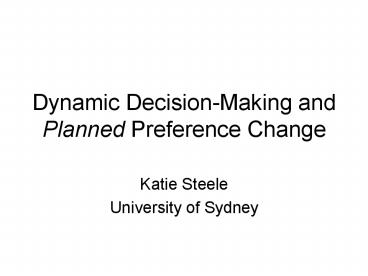Dynamic Decision-Making and Planned Preference Change - PowerPoint PPT Presentation
1 / 13
Title:
Dynamic Decision-Making and Planned Preference Change
Description:
Belief/desire diachronic norms come apart from decision norms ... How can there be a plausible diachronic DBA for desire-updating when we are ... – PowerPoint PPT presentation
Number of Views:59
Avg rating:3.0/5.0
Title: Dynamic Decision-Making and Planned Preference Change
1
Dynamic Decision-Making and Planned Preference
Change
- Katie Steele
- University of Sydney
2
Ulysses Dynamic Decision Problem
O1 on course for Ithaca
leave sirens
2
unconstrained
O2 forever with sirens
remain with sirens
1
tied to mast
O3 on course for Ithaca, with rope burn
Current preferences O1 gt O3 gt O2
3
Normative Question
- How to define a rational choice in the dynamic
decision-making context? - What expectations about future beliefs and
desires count as rational? - My position dynamic model just an expanded
representation of the standard static decision
problem. (Ulysses problem is a valid dynamic
decision problem.)
4
(Strict) Conditionalisation
- Prfinal(Q) Prinitial(QE)
- (E represents what agent has learnt/become
certain of.) - (Prinitial(EQ) ? Prinitial(Q)) /
Prinitial(E) - What does the rule demand of a rational agent?
- dictates how beliefs should change with time?
- or a mere plan for updating beliefs?
5
Desire Analogue of Conditionalisation?
- ConditionalisationD Ufinal(Q) Uinitial(QE)
- where U(QE) U(Q E)
- SumU(wj) ? Pr(wj Q E)
- (Here the wj are all worlds in which Q E is
true.) - SumU(wj) ? Pr2(wj Q)
- where Pr2() Pr( E)
- (Here the wj are all worlds in which Q is
true.) - E.g. U(go to beachraining) U(go to beach and
raining)
6
Interpreting diachronic belief/desire norms
- Either
- Belief/desire diachronic norms come apart from
decision norms - Or else interpret conditionalisation (and maybe
conditionalisationD) so that the rule is amenable
to Ulysses plight.
7
Diachronic Dutch Book Arguments
- I think there is a plausible version of the
diachronic DBA for conditionalisation as a plan
for updating beliefs. - (follows Skyrms 1993).
- A non-conditionaliser will sometimes choose a
strategy that is dominated by another strategy
that would have been available, were the agent to
plan on updating via conditionalisation. - Losses are measured according to the utility for
money, which is assumed to be stable with time.
8
Asymmetry between belief and desire?
- So an agent should always at least plan to update
their beliefs in accordance with
conditionalisation - But what is the case for desires? Even if we are
deflationary about diachronic norms, it seems
plausible that an agent can plan to update their
desires contrary to conditionalisationD. - (e.g. agent currently prefers smoking to not
smoking, but they actually plan to have the
opposite preference)
9
Diachronic DBA for Desire?
- How can there be a plausible diachronic DBA for
desire-updating when we are missing an important
ingredient a stable utility function against
which to measure sure losses? - We can show that an agent who does not subscribe
to conditionalisationD can suffer a sure loss
(due to a better strategy being unavailable to
them) relative to their current utility function - But why should this matter if the agents
desires at the future time in question are
respected?
10
A suggestion for planned changes in desire
- Agent plans a change in desire to the extent that
they pursue a strategy in part because they find
the predicted change in desire attractive. - Motivated by current higher order desires about
what ones utility function will be at various
future times. - Just need to describe possible prospects in
sufficient detail so that they include this kind
of utility information.
11
Ulysses Dynamic Decision Problem
O1 on course for Ithaca
leave sirens
2
unconstrained
O2 forever with sirens
remain with sirens
1
tied to mast
O3 on course for Ithaca, with rope burn
Current preferences O1 gt O3 gt O2
12
Ulysses Again
take harp
O1 Unew
Stop on island
2
leave harp
O2 Unew
1
Continue to Ithaca
O3 Uold
O3 gt O2 gt O1 But also (O1 Unew) gt (O2
Unew) gt (O3 Uold)
13
Genuine desire change?
- Examples to motivate planned changes in desire
involve centred prospects. - e.g. prefer smoking to not smoking now but
prefer to prefer not smoking to smoking later - But these are not the sort of prospects that are
evaluated in the decision model. Rather, whole
world histories that include smoking at time t. - Not so obvious that an agent would seek an
alternative utility function over whole world
histories that they do not currently hold

